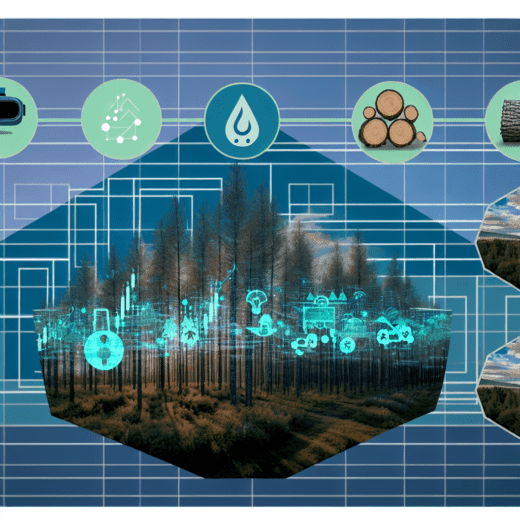Exploring Sustainable Forestry Training Programs
Understanding the Importance of Sustainable Forestry
Sustainable forestry has become a focal point of environmental preservation efforts worldwide. As the demand for wood products increases, maintaining forest ecosystems is critical not only to support biodiversity but also to ensure long-term resources for future generations. At the heart of this balance lies the necessity of training forest workers in sustainable and low-impact forestry methods—practices that are beginning to show their innovation potential, as well as their capacity to disrupt traditional forestry markets. These programs are crucial in guiding forest management practices to enhance conservation efforts while maintaining economic viability.
Innovation Potential in Sustainable Forestry Training
Training programs in sustainable forestry are evolving rapidly, driven by technological advancements and green economies. Innovative training solutions, such as augmented reality (AR) and virtual reality (VR) tools, are gaining traction in providing immersive learning experiences for forest workers. These tools allow interactive training scenarios without the ecological disturbances that accompany on-the-ground practices. The ability of these technologies to simulate real-world forestry operations is not only cost-effective but also provides comprehensive risk assessment training.
One shining example of innovation in the field is the integration of machine learning to monitor forest conditions and predict areas needing conservation attention. Startups, such as SilviaTerra, are deploying satellite imagery combined with artificial intelligence (AI) to offer precise forest mapping and resource management, thereby revolutionizing forestry training with data-driven insights.
Market Disruption: A Paradigm Shift in Forestry
The introduction of sustainable forestry training presents a significant disruption in the market. Traditional forestry operations rely heavily on extractive methods that often lead to deforestation and habitat destruction. By challenging these norms, startups focusing on sustainable training programs contribute to a paradigm shift. They instill in forest workers an understanding of eco-friendly practices, emphasizing selective logging and forest restoration techniques that maintain diverse ecosystems.
The shift is facilitated by market demands for sustainably sourced products, where consumers and companies alike favor goods that bear eco-certifications. This demand is encouraging more forestry companies to participate in sustainability training programs, creating a potent business ecosystem that supports environmental goals.
Key Challenges in Implementing Sustainable Training Programs
While the potential for sustainable forestry training is enormous, startups face several challenges. The primary obstacle is financial, as developing comprehensive training modules can be capital-intensive. Furthermore, there is often resistance from traditional forestry industries, where change is met with skepticism and reluctance to deviate from conventional methods.
Geographic and socio-economic factors also pose challenges. Training programs must be adaptable to diverse cultural and environmental contexts, which requires careful customization and localization of content. For instance, what works in the temperate forests of North America may not be applicable in the tropical settings of South-East Asia.
Seizing Unique Opportunities: The Future of Forestry Training
Opportunities for startups in sustainable forestry training abound, particularly those that can leverage technology to overcome existing barriers. Enhanced focus on climate change and international commitments to sustainability open avenues for collaboration with international environmental organizations and forest certification bodies.
Startups that can demonstrate the economic benefits of sustainable practices—such as long-term profitability through continuous yield and reduced damage to ecosystems—position themselves well for success. Engagement with indigenous communities and local stakeholders is another area ripe for opportunity, as these groups often possess invaluable knowledge and techniques inherently aligned with sustainable practices.
Critical Strategies for Success
-
Fundraising: Effective fundraising is critical for startups in this niche. Identifying investors aligned with environmental and social governance (ESG) criteria can provide the necessary capital. Platforms like Y Combinator offer mentorship and financial support to budding startups in this domain.
-
Scaling: Developing a scalable training model is essential. Ready Tech Go, a startup recognized for its virtual training simulations, successfully scales by offering customizable, multilingual platforms adaptable to different forestry contexts. This approach extends reach and relevance, making sustainable methods accessible worldwide.
-
Achieving Product-Market Fit: Understanding the nuances of forestry operations and customizing training solutions to fit these markets is a critical strategy. Startups should engage in rigorous research, including direct consultations with forestry companies, to tailor programs that meet specific operational needs.
-
Customer Acquisition: Building partnerships with environmental NGOs, government bodies focused on natural resources, and private sector stakeholders provides a solid customer base. Demonstrating value through pilot projects and data showcasing improved conservation outcomes will enhance credibility and attract new adopters.
-
Unique Business Models and Technologies: Success hinges on distinctive business models that emphasize service delivery and continuous innovation. Adopting a subscription-based model, for instance, can provide steady revenue streams while encouraging ongoing engagement from forestry professionals.
Case Studies: Learning from Success
The experience of Forest Mapper, a startup focused on AR-based forestry training, offers relevant insights. By forging a partnership with several major forestry companies and emphasizing certification compliance, they have set a benchmark in innovation and customer satisfaction.
In another example, the Finnish startup Metsä Group has utilized blockchain technology to enhance transparency in the supply chain. By assuring consumers of the sustainability and legality of wood products, they have gained a competitive edge, showcasing how integrating cutting-edge technology into sustainability initiatives drives both ecological and economic gains.
Academic Perspectives and Industry Reports
Academic research plays a significant role in shaping sustainable forestry practices. Studies from institutions like the Yale School of Forestry and Environmental Studies provide evidence-based methodologies that enhance training curricula. Furthermore, reports from the World Wildlife Fund and the United Nations Environment Programme provide essential data and guidelines that inform best practices in sustainability education.
Concluding Thoughts
As the world increasingly recognizes the importance of environmental conservation, sustainable forestry training programs present a vital intersection of ecological preservation and market opportunity. Startups venturing into this arena should focus on delivering innovative, adaptable, and effective training solutions that meet the dual needs of productivity and preservation.
The pathway to success involves understanding the intricate balance between innovation and tradition, and those capable of navigating these waters will contribute significantly to a more sustainable future. In the end, sustainable forestry training programs are not just about educating forest workers; they are about reshaping the future of our planet’s forests to ensure they thrive for generations to come.

